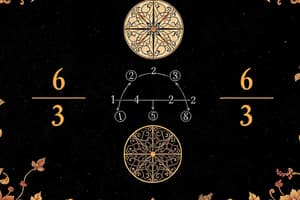Podcast
Questions and Answers
What must be done before adding or subtracting fractions with denominators less than or equal to ten?
What must be done before adding or subtracting fractions with denominators less than or equal to ten?
- Find the greatest common multiple of the denominators
- Ensure the denominators are the same (correct)
- Ensure the numerators are the same
- Convert both fractions to decimals
In the example 3/4 + 1/2, what is the resulting sum after finding a common denominator?
In the example 3/4 + 1/2, what is the resulting sum after finding a common denominator?
- 3/16 (correct)
- 7/4
- 5/8
- 11/8
What is the least common multiple of 4 and 2 in the context of adding fractions?
What is the least common multiple of 4 and 2 in the context of adding fractions?
- 6
- 8
- 4 (correct)
- 2
In subtraction of fractions, what do we replace subtraction with?
In subtraction of fractions, what do we replace subtraction with?
If we want to subtract 1/3 from 2/4, what should the denominators be converted to before performing the operation?
If we want to subtract 1/3 from 2/4, what should the denominators be converted to before performing the operation?
What is the result of subtracting 4/12 from 3/12?
What is the result of subtracting 4/12 from 3/12?
What is the result of dividing 5 by 1/4?
What is the result of dividing 5 by 1/4?
If we multiply 2/3 by 3/4, what do we get?
If we multiply 2/3 by 3/4, what do we get?
What is the result of dividing 7 by 1/7?
What is the result of dividing 7 by 1/7?
When we divide 10 by 2/5, what is the outcome?
When we divide 10 by 2/5, what is the outcome?
If we multiply 4/9 by 9/4, what is the product?
If we multiply 4/9 by 9/4, what is the product?
What is the result of dividing 6 by 3/8?
What is the result of dividing 6 by 3/8?
Flashcards are hidden until you start studying
Study Notes
Fractions are a fundamental concept in mathematics used to represent parts of a whole. When it comes to fractions with denominators below ten, we encounter some unique properties due to their limited divisors. Here's a brief overview of how these fractions can be understood in terms of division, multiplication, addition, and subtraction when the denominator is less than or equal to ten:
Division by Denominators Below Ten
Division is a process that involves sharing one quantity evenly into another quantity called the divisor. In the case of dividing by a fraction, we find out what part of the dividend is equivalent to the divisor. For example, if we divide 8 by 1/2, we get 16 because each half goes into 8 twelve times. Similarly, dividing 9 by 1/3 gives us 27 because three goes into nine twice.
Multiplication by Denominators Below Ten
Multiplication involves finding how many times one quantity or factor is contained within another quantity or factor. When multiplying by fractions with denominators below ten, we can think of the multiplication as repeated addition of fractions with the same denominator. For instance, if we multiply 3/4 by 2/3, we get 6/9 because two thirds goes into three fourths twice. Similarly, when multiplying 1/2 by 1/5, we get 1/10 because four fifths goes into eight halves twice.
Addition and Subtraction of Fractions with Denominators Below Ten
Addition and subtraction are operations that involve combining or separating quantities. When adding or subtracting fractions with denominators less than or equal to ten, we need to ensure the denominators are the same before performing the operation. If they're not, we must first find the least common multiple (LCM) of the denominators and convert both fractions to have this LCM as their denominator:
For example, consider adding 3/4 + 1/2. Since they don't share a common denominator, we find the LCM of 4 and 2, which is 4. We then rewrite both fractions so that they have this common denominator: 3/4 = 3/4 * (1/4)/(1/4) = 3/16 while 1/2 = 1/2 * (2/2)/(1/2) = 1/2. Now we add these simplified fractions: 3/16 + 1/2 = 3/16 + 2/16 = 5/16.
Similarly, for subtraction, we follow the same procedure but replace subtraction with the opposite operation. For instance, let's say we want to subtract 1/3 from 2/4. First, we make sure that both fractions have the same denominator, which in this case is 12, since 3 × 4 = 12. So, we write 1/3 as 4/12 and 2/4 as 3/12. Then, we perform the subtraction: 4/12 - 3/12 = 1/12.
Studying That Suits You
Use AI to generate personalized quizzes and flashcards to suit your learning preferences.




